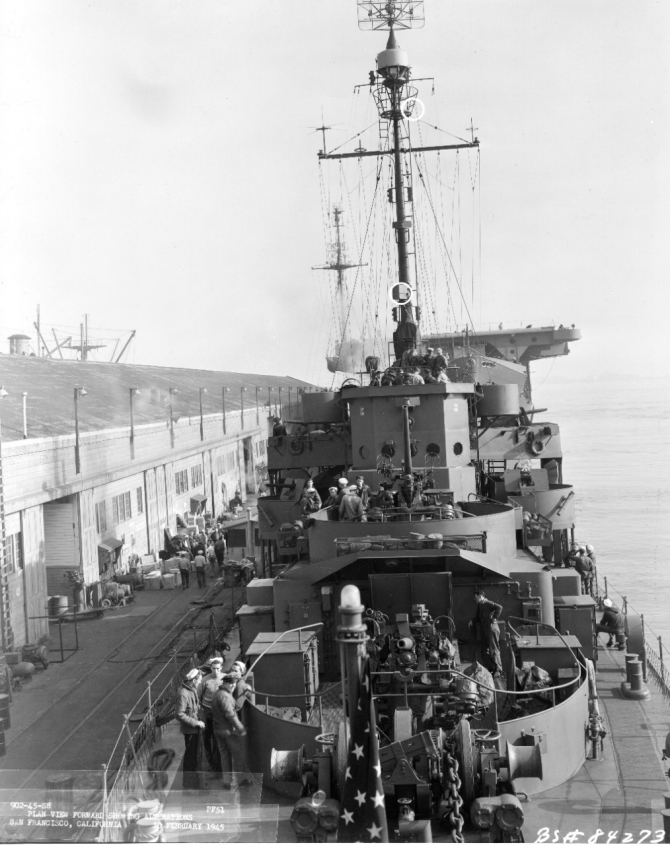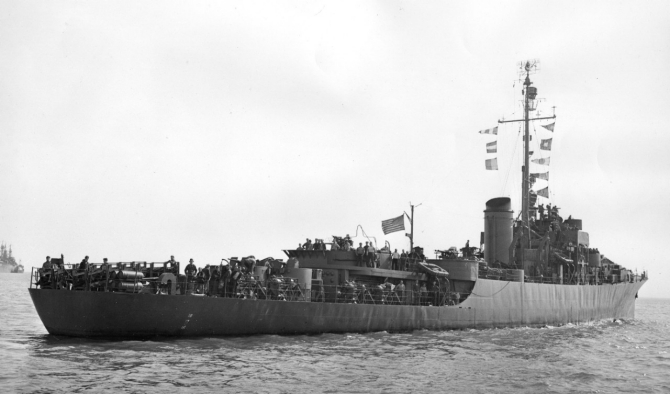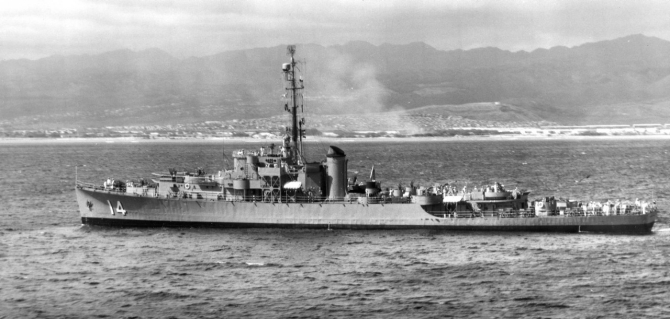Burlington I (PF-51)
1944–1953
The first U.S. Navy ship named for the city in Iowa.
(PF-51: displacement 1,430; length 303'11"; beam 37'6"; draft 13'8"; speed 20.3 knot; armament 2 3-inch, 4 40 millimeter, 9 20 millemeter, 2 depth charge tracks, 8 depth charge projectors, 1 depth charge projector (Hedgehog); class Tacoma; type S2-S2-AQ1)
The first Burlington (PF-51) was laid down under a Maritime Commission contract (M.C. Hull 1462) on 19 October 1943 at Wilmington, Calif., by Consolidated Steel Corp., Ltd.; launched on 7 December 1943; sponsored by Mrs. Max A. [Florence] Conrad, wife of the Mayor of Burlington, Iowa; acquired by the Navy on 31 March 1944; and commissioned on 3 April 1944, Lt. Cmdr. E. B. Carlson, USCG, in command.
The USCG-manned Burlington got underway from San Pedro, Calif., on 1 August 1944 following shakedown and completion of post-shakedown availability. Her first assignment took her to Espiritu Santo, New Hebrides, then to carry out patrol and escort duties supporting operations in western New Guinea from 21 August. Subsequently, from 16 October until 18 November, Burlington escorted convoys between New Guinea and the Philippine Islands in support of the invasion of Leyte. She departed that area on 3 December and returned to California, arriving at San Francisco on Christmas Day 1944 to begin an availability.


After voyage repairs and preparations for cold weather operations, Burlington sailed on 18 February 1945 for the Aleutian Islands, arriving at Dutch Harbor on 26 February where she was assigned to Escort Division 43 for patrol and escort duty. Between 18 July and 2 August she underwent repairs and alterations at Tacoma, Wash., in preparation for her slated transfer to the Soviet Union in Project Hula. On 8 August, Burlington departed Seattle for Cold Bay, Alaska, where she engaged in training a prospective Soviet crew until 26 August 1945, when she decommissioned and transferred to the Soviet Union under Lend-Lease. Classified as an escort vessel (storozhevoi korabl), Burlington was renamed EK-21.
Returned to United States’ custody on 14 November 1949, Burlington was recommissioned on 5 January 1951 at Yokosuka, Japan, and assigned to Escort Squadron 7, Pacific Fleet. After shakedown and training exercises off Yokosuka, Burlington proceeded to Korean waters where, from 14 March to 24 April, she operated in Wonsan Harbor and off Songjin, bombarding shore targets, performing escort and patrol duty, and serving as harbor entrance control vessel and guard ship at Wonsan. On 11 May, after a brief period at Sasebo, Japan, she returned to the combat zone and performed patrol duty and bombarded designated targets in the Wonsan-Chongjin-Songjin area until 8 June.
During the summer of 1951, the ship carried out escort duty with Task Force (TF) 92 and TF 77 in the replenishment area off the east coast of Korea. Between 5 December 1951 and July 1952 Burlington continued combat operations in Korean waters. Her principal duty was acting as escort for Task Group 92.11 in the replenishment area off the east coast of Korea. She also patrolled, transported casualties, bombarded shore targets, and furnished fire support for mining operations in the Wonsan and Hungnam areas.
On 3 July 1952, Burlington departed Sasebo for the Philippine Islands where she engaged in training exercises off the west coast of Luzon and cruised as far south as Davao, Mindanao. She departed Manila Bay on 3 September for Yokosuka, Japan.
Placed out of commission, in reserve, at Yokosuka on 15 September 1952 Burlington was stricken from the Naval Vessel Register on 28 May 1953. Acquired by the government of Colombia, the ship was “transferred with appropriate ceremony” to that country on 26 June 1953, being renamed Almirante Brion.

Burlington received two battle stars for her World War II service and five battle stars for service in the Korean conflict.
Raymond A. Mann
Updated 29 June 2016 and 4 August 2022.


